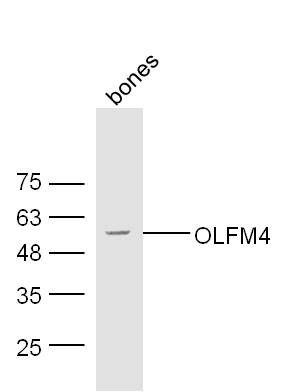Olfactomedin-4, also known as G-CSF-stimulated clone 1 protein, Antiapoptotic protein GW112, and OLFM4, is a secreted protein which contains one olfactomedin-like domain. OLFM4 is expressed during myeloid lineage development. It is strongly expressed in the prostate, small intestine and colon and moderately expressed in the bone marrow and stomach. OLFM4 is highly expressed in pancreatic cancer tissues and shows an elevated expression level during the early S phase of the cell cycle. It is also expressed at high levels in stomach cancer and colon cancer tissues. Inhibition of ROS or the ERK pathway remarkably decreased G-CSF-induced OLFM4 expression. OLFM4 is an antiapoptotic factor that promotes tumor growth. OLFM4 promotes proliferation of pancreatic cancer cells by favoring the transition from the S to G2/M phase. OLFM4 also facilitates cell adhesion. Induction of OLFM4 in cancer cells was reported to have a novel antiapoptotic action via binding to the potent apoptosis inducer GRIM-19. The human OLFM4 is also thought to be a useful marker for early myeloid development.
Function:
May promote proliferation of pancreatic cancer cells by favoring the transition from the S to G2/M phase. In myeloid leukemic cell lines, inhibits cell growth and induces cell differentiation and apoptosis. May play a role in the inhibition of EIF4EBP1 phosphorylation/deactivation. Facilitates cell adhesion, most probably through interaction with cell surface lectins and cadherin.
Subunit:
Homomultimer; disulfide-linked. Interacts with NDUFA13. Interacts with cell surface lectins (locutions ricinus communis agglutinin I, concanavalin-A and wheat germ agglutinin) and cadherin.
Subcellular Location:
Secreted, extracellular space. Mitochondrion. Note=Subcellular location is not clearly defined: has been shown to be secreted (PubMed:16566923), but also in the mitochondrion (PubMed:15059901 and PubMed:20724538), cytoplasm and plasma membrane (PubMed:20724538) and in the nucleus (PubMed:15059901).
Tissue Specificity:
Expressed during myeloid lineage development. Much higher expression in bone marrow neutrophils than in peripheral blood neutrophils (at protein level). Strongly expressed in the prostate, small intestine and colon and moderately expressed in the bone marrow and stomach. Overexpressed in some pancreatic cancer tissues.
Post-translational modifications:
N-glycosylated.
Similarity:
Contains 1 olfactomedin-like domain.
SWISS:
Q6UX06
Gene ID:
10562
Database links:
Entrez Gene: 467367 Chimpanzee
Entrez Gene: 515082 Cow
Entrez Gene: 485470 Dog
Entrez Gene: 10562 Human
Entrez Gene: 380924 Mouse
Entrez Gene: 290409 Rat
Omim: 614061 Human
SwissProt: Q6UX06 Human
SwissProt: Q3UZZ4 Mouse
Unigene: 508113 Human
Unigene: 26456 Mouse
Unigene: 156265 Rat
| Picture |
Sample: Bone (Mouse) Lysate at 40 ug
Primary: Anti-OLFM4 (SL6558R) at 1/300 dilution
Secondary: IRDye800CW Goat Anti-Rabbit IgG at 1/20000 dilution
Predicted band size: 55 kD
Observed band size: 55 kD
|
|
|
